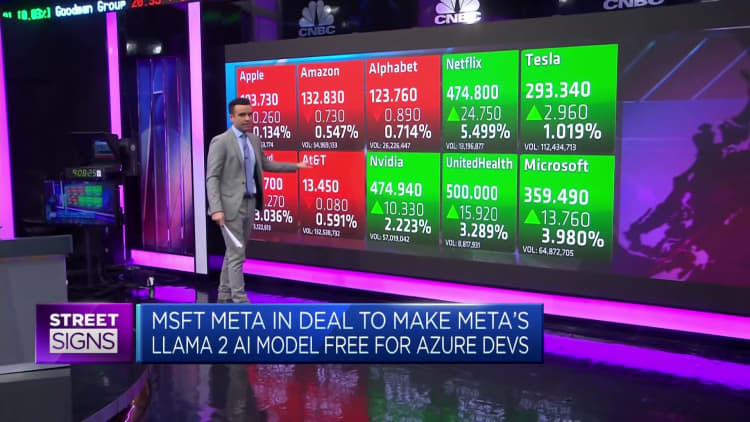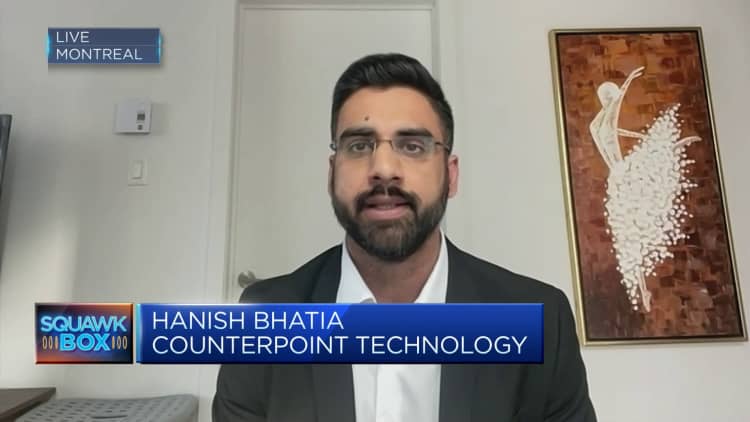[ad_1]
Jonathan Raa | Nurphoto | Getty Images
Mike Monegan saw the writing on the wall in January. For weeks, he’d had difficulty sleeping.
As vice president of product management for Australian artificial intelligence software vendor Appen, Monegan and many of his colleagues had been doing their best to keep things afloat as tech behemoths slashed their spending on the company’s AI training data.
Five customers — Microsoft, Apple, Meta, Google, and Amazon — accounted for 80% of Appen’s revenue, and this was supposed to be the company’s moment to shine. Across the industry, companies were committing to hefty investments in generative AI, trying to ensure they weren’t left behind in the sudden race to embed the latest large language models into all of their projects.
Appen has a platform of about one million freelance workers in more than 170 countries. In the past, it’s used that network of people to train some of the world’s leading AI systems, working for a star-studded list of tech companies, including the top consumer names as well as Adobe, Salesforce and Nvidia.
But just as AI’s big moment was arriving, Appen was losing business — and fast. Revenue declined 13% in 2022, a drop the company attributed in part to “challenging external operating and macro conditions.” Former employees, who asked not to be named for fear of retaliation, told CNBC that the company’s current struggle to pivot to generative AI reflects years of weak quality controls and a disjointed organizational structure.
In mid-December, Appen announced a change at the top. Armughan Ahmad, a 25-year veteran of the tech industry, would be taking over as CEO, replacing Mark Brayan, who had helmed the company for the prior seven years. Upon starting the following month, Ahmad called generative AI “one of the most exciting advancements” in the industry and noted that he “was happy to learn that our team has already put the technology to work on our marketing content.”
Monegan wasn’t buying it. He told CNBC that after his first meeting with Ahmad he began looking for another job. Monegan had been watching Appen fall behind, and he didn’t see Ahmad, whose LinkedIn profile says he’s based in Seattle, presenting a realistic path out.
Monegan left in March to help start his own company.
The numbers seem to prove him right.
Despite Appen’s enviable client list and its nearly 30-year history, the company’s struggles have intensified this year. Revenue in the first half of 2023 tumbled 24% to $138.9 million, amid what it called a “broader technology slowdown.” The company said its underlying loss widened to $34.2 million from $3.8 million a year earlier.
“Our data and services power the world’s leading AI models,” Ahmad said on last week’s earnings call. “However, our results are far from satisfactory. They reflect the ongoing global macroeconomic pressures and continued slowdown in tech spending, particularly amongst our largest customers.”
In August 2020, Appen’s shares peaked at AU$42.44 on the Australian Securities Exchange, sending its market cap to the equivalent of $4.3 billion. Now, the stock is trading at around AU$1.52, for a market cap of around $150 million.
‘Resetting the business’
Along with its troubled financials, the company is dealing with a string of executive departures. Helen Johnson, who was appointed finance chief in May, left after just seven weeks in the role. Marketing chief Fab Dolan, whose departure was announced on the earnings call, spent just over two months in the position. The departure of Chief Product Officer Sujatha Sagiraju was also just announced.
“In the environment of a turnaround, we anticipate changes,” a representative for Appen told CNBC.
Elena Sagunova, global human resources director, left in April, followed by Jen Cole, senior vice president of enterprise, in July and Jukka Korpi, senior manager of business development for the Europe, Middle East and Africa Region, in August.
Still, Ahmad said on the earnings call that the company remains “laser-focused on resetting the business” as it pivots to providing data for generative AI models. He added that “the benefits from our turnaround have yet to show meaningful results” and that “the revenue growth does not offset the declines we are experiencing in the remainder of the business.”
Appen’s past work for tech companies has been on projects like evaluating the relevance of search results, helping AI assistants understand requests in different accents, categorizing e-commerce images using AI and building out map locations of electric vehicle charging stations, according to public information and interviews conducted by CNBC.
Appen has also touted its work on search relevance for Adobe and on translation services for Microsoft, as well as in providing training data for lidar companies, security applications and automotive manufacturers.
Depending on the data that a customer requires, an Appen freelancer could be sitting at a laptop to label or categorize images or search results or using Appen’s mobile application to capture the sounds of glass breaking or background noise in a vehicle.

During Appen’s growth years, that manual collection of data was key for the state of AI at the time. But LLMs of today have changed the game. The underlying models behind OpenAI’s ChatGPT and by Google’s Bard are scouring the digital universe to provide sophisticated answers and advanced images in response to simple text queries.
To fuel their LLMs, which are powered largely by state-of-the-art processors from Nvidia, companies are spending less on Appen and a lot more on competitive services that already specialize in generative AI.
Ahmad told CNBC in a statement that, while the company’s financials are being hurt by the economy and a reduction in spending by top customers, “I’m confident that our disciplined focus and the early progress we are making to turn around the business will enable us to capture value from the growing generative AI market and return Appen to growth.”
Cash-strapped
Ahmad said on the earnings call that there’s customer interest in niche types of data that’s more difficult to acquire. For Appen, that would mean finding specialists in particular types of information that can bolster generative AI systems. That also means it needs to expand its base of workers while simultaneously finding ways to preserve cash.
Appen’s cash on hand was $55 million as of June 30, thanks to proceeds from a $38 million equity raise. Prior to the new infusion, cash had been dwindling, from $48 million at the end of 2021 to $23.4 million a year later.
Even before the generative AI transition, wages for Appen’s data labelers were a sticking point. In 2019, Google said its contractors would need to pay their workers $15 an hour. Appen didn’t meet that requirement, according to public letters written by some workers.
In January, after months of organizing, raises went into effect for Appen freelancers working on the Bard chatbot and other Google products. The rates went up to between $14 and 14.50 per hour.
That wasn’t the end of the story. In May, Appen was accused of squeezing freelancers focused on generative AI, allotting strict time limits for time-consuming tasks such as evaluating a complex answer for accuracy. One worker, Ed Stackhouse, wrote a letter to two senators stating his concerns about the dangers of such constrained working conditions.
“The fact that raters are exploited leads to a faulty, and ultimately more dangerous product,” he wrote. “Raters are not given the time to deliver and test a perfect AI model under the Average Estimated Time (AET) model they are paid for,” a practice that “leads raters to spot check only a handful of facts before the task must be submitted,” he added.
In June, Appen faced charges from the U.S. National Labor Relations Board after allegedly firing six freelancers who spoke out publicly about frustrations with workplace conditions. The workers were later reinstated.
Appen employees who spoke to CNBC on behalf of the company in recent months said the rapidly changing AI environment poses challenges. Erik Vogt, vice president of solutions at Appen, told CNBC in May that the sector was in a state of flux.
“There’s a lot of uncertainty, a lot of tentativeness for experimentation, and new startups trying out new things,” Vogt said. “How to make new use cases a reality usually means acquiring unusual data – sometimes astronomical volumes of data, or highly rare resource types. There’s a need for specialists in a wide range of different capabilities.”
For recent projects, Vogt said Appen needed to enlist the help of doctors, lawyers and people with experience using project-tracking software Jira.
“People you wouldn’t necessarily think of as being gig workers, we had to engage with these specialists for these expert systems in a way there hadn’t been a huge demand for before,” Vogt said.
Kim Stagg, Appen’s vice president of product, said the work required for generative AI services was different than what the company has needed in the past.
“A lot of work we’ve done has been around the relevance of search for big engines – a lot of those are more, ‘Is this a hot dog or not,’ ‘Is this a good search or not,'” Stagg said. “With generative AI, we see a different demand.”
One focus Stagg highlighted was the need to find “what we would call really good quality creative people,” or those who are particularly good with language. “And another is domain experts: sports, hobbies, medical.”
However, former employees expressed deep skepticism of Appen’s ability to succeed given its tumultuous position and the executive shuffling taking place. Part of the problem, they say, is the organizational structure.
Appen was divided into a global business unit and an enterprise business unit, which were at one time made up of about five clients and more than 250 clients, respectively. Each had a separate team and communication between them was limited, creating inefficiencies internally, ex-employees said. One former manager said it felt like two separate companies. Appen said that in the last quarter, the company has integrated the global and enterprise business units.
The company’s plunging stock price suggests that investors don’t see the company’s business offerings transferring to the generative AI space.
Lisa Braden-Harder, who served as CEO of Appen until 2015, echoed that sentiment, telling CNBC that “data-labeling is completely different” than how data collection works in a ChatGPT world.
“I am not clear that their past experience of data labeling is a competitive advantage now,” she said.
Former Appen employees say the company has in recent years been dealing with quality control problems, hurting its ability to provide valuable training data for AI models. For example, one former department manager said people would annotate rows of data using automated tools instead of the manual data labeling required for accuracy, which is what clients thought they were buying.
Customers’ expectations of a “clean data set” were often not met, the person said, leading them to leave Appen for competitors such as Labelbox and Scale AI. When the manager started at the company, there were more than 250 clients in the enterprise business unit. Within 18 months, he said, that number had dwindled to less than 100.
Appen told CNBC that in the first half of the year it “secured 89 new client wins.”
Monegan recalled that many customer relationships were “hanging on by a thread.”
Following the earnings report, Canaccord Genuity analysts cut their price target on Appen by more than half to AU$1.56. One concern the analysts referenced was a 34% reduction in spending by Appen’s top customer, a number that Appen wouldn’t confirm or deny.
The more existential problem, the analysts note, revolves around Appen’s effort to win business while also looking to cut costs by 31% in fiscal 2023.
“That seems like a brutal level of cost reduction,” they wrote, as the company tries to stabilize its “core revenue base while growing a business around Generative AI.”
WATCH: AI is the next trend to watch when it comes to smartphones, says market research firm

[ad_2]

